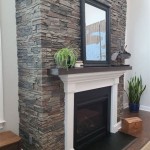Hole in the Wall Gas Fireplaces: A Comprehensive Guide
Gas fireplaces are a popular choice for homeowners seeking to enhance their living spaces with warmth, ambiance, and aesthetic appeal. Among the various types available, hole-in-the-wall gas fireplaces offer a unique and modern design that seamlessly integrates with contemporary homes. This article provides a comprehensive guide to hole-in-the-wall gas fireplaces, exploring their features, benefits, considerations, and installation process.
What are Hole-in-the-Wall Gas Fireplaces?
As the name suggests, hole-in-the-wall gas fireplaces are designed to be installed directly into an existing wall. This creates a clean, minimalist look that eliminates the need for a traditional fireplace surround or mantel. The fireplace unit itself is typically recessed into the wall, leaving only the firebox visible. The design allows for a more contemporary and streamlined aesthetic that blends seamlessly with modern interior design styles.
Benefits of Hole-in-the-Wall Gas Fireplaces
Hole-in-the-wall gas fireplaces offer numerous benefits that make them an attractive option for homeowners:
1. Aesthetic Appeal and Space Optimization
The sleek, modern design of hole-in-the-wall fireplaces creates a contemporary focal point without taking up valuable floor space. They are particularly well-suited for smaller living rooms or spaces where maximizing floor area is essential.
2. Convenience and Efficiency
Gas fireplaces are known for their convenience, offering effortless ignition and temperature control with the simple flip of a switch. They also boast high energy efficiency, making them a cost-effective heating solution for smaller spaces.
3. Versatility and Customization
Hole-in-the-wall fireplaces come in various sizes and styles, allowing for customization to suit individual preferences and design aesthetics. They can be integrated into walls made of various materials, such as drywall, brick, or stone.
Considerations for Choosing a Hole-in-the-Wall Gas Fireplace
Before making a purchase, it's essential to consider several factors:
1. BTU Output and Heating Capacity
The BTU output of a gas fireplace determines its heating capacity. It's crucial to choose a fireplace that provides adequate warmth for the size of your room. Consider factors such as room insulation and the desired temperature increase.
2. Gas Line Requirements
Ensure that your home has an existing gas line or that it is feasible to install one. Installation costs can vary depending on factors like the gas line distance and the complexity of the installation.
3. Venting Options
Hole-in-the-wall fireplaces require proper venting to ensure safe and efficient operation. Vent options include direct vent, which vents horizontally through the wall, and B-vent, which vents vertically through the roof. Choose the venting system that best suits your home's structure and local building codes.
4. Firebox Material and Design
Firebox materials commonly used in hole-in-the-wall fireplaces include steel, cast iron, and ceramic. Consider the firebox material based on your aesthetic preferences and heating requirements. Additionally, the size and shape of the firebox will influence the visual impact and heat output of the fireplace.
Installation Process for Hole-in-the-Wall Gas Fireplaces
The installation of a hole-in-the-wall gas fireplace requires professional expertise and adherence to safety guidelines. The process typically involves the following steps:
1. Planning and Design
The first step involves consulting with a qualified fireplace installer to determine the ideal location for the fireplace and the necessary venting requirements.
2. Wall Preparation
The wall needs to be prepared to accommodate the fireplace unit, involving cutting a hole to the specified size and reinforcing the surrounding structure.
3. Installation of the Fireplace Unit
The fireplace unit is carefully installed into the prepared wall opening, ensuring proper alignment and secure mounting.
4. Gas Line Connection
A certified gas fitter connects the gas line to the fireplace unit, ensuring proper sealing and leak detection.
5. Venting Installation
The selected venting system is installed following local building codes and regulations.
6. Final Inspections
The installation is inspected by a qualified inspector to confirm compliance with safety standards and ensure proper operation.
By understanding the various aspects of hole-in-the-wall gas fireplaces, homeowners can make informed decisions and choose a fireplace that complements their home's style and heating needs.

Hole In The Wall Gas Fire A Guide Grand Designs

Connelly Denver Wide He Brushed Trim Fireplace Saver

Crystal Fires Emerald Hole In The Wall Gas Fire Flames Co

Gas Fires High Efficiency Hole In The Wall Real Bespoke Fireplaces Made To Measure

Can I Put A Hole In The Wall Gas Fire Against Wallpaper Trafford Fireplaces Carlisle Cumbria

Flavel Rocco Balanced Flue Hole In The Wall Gas Fire Direct Fireplaces

Gazco Gas Fires Glasgow Studio Hole In The Wall

Connelly Denver Wide He Grande Trim Fireplace Saver

Hole In The Wall Installation Guide Direct Fireplaces

Hole In The Wall Gas Fires Archives Fireplace Company Haydock
Related Posts








